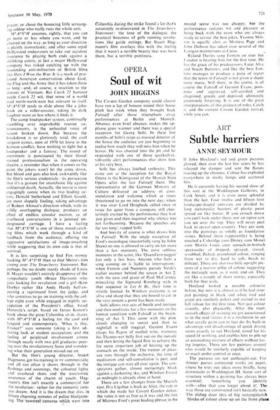ART
Subtle barriers
ANNE SEYMOUR
If John Hoyland's red and green pictures glowed, then over the last few years he has released the damper and sent the flames roaring up the chimney. Colour has exploded everywhere in slushy lumps and scattered bits.
He is currently having his second show of this sort at the Waddington Galleries, in Cork Street, and it is even more splendid than the last. Four twelve and fifteen foot landscape-shaped canvases are divided by long rectangular barriers of plastic paint spread on like butter. If you crouch down you can't look under them, nor on tiptoe can you see over the top. They will never peel back to reveal open country. They are sunk into the paintings as solidly as foundation stones. Behind them (apparently) is being enacted a Coleridge cum Disney cum Monet cum Morris Louis cum spinach-in-bortsch spectacular of dripped, sprayed, stirred, scrubbed, flicked, granulated colour, ranging from wet to dry, hard to soft, brash to delicate. There arc also two little upright pic- tures of a narrow pillar of colour suggesting the rectangle seen, as it were, end on. They are like a couple of short stories, especially built for that scale.
Hoyland looked a notable colourist before, but now it is almost as if he had stop- ped painting in black and white (red and green are similarly polar) and started to use full colour for the first time. Not just colour visually, also physically. After the matt, smooth effects of staining we got accustomed to in the mid-'sixties it is a revelation to see what acrylic paint can in fact do. Its built-in advantage and disadvantage of quick drying seems exactly to suit Hoyland, noted for his speed of working. and enables him to pile up an astonishing mixture of effects without los- ing impetus. There are few painters around who would be similarly capable of keeping so much under control at once.
The pictures arc not unthought-out. For thinner purses connected works on paper, where he tries out ideas more briefly, hang downstairs at Waddington Ill. Some sort of structure within a painting has always been essential: 'something you identify with—after that you forget about it'. The way these are constructed isn't basically new. The sliding door idea of big rectangularish blocks of colour close up on the front plans
was already in use in 1965, chains of smaller blocks set right across the middle of his can- vas in 1964 and related effects even earlier.
Though surfaces have always been sensuous and sometimes thickly painted, Hoyland's attraction to paint as substance seems initially to have been sublimated to other needs. Yet it didn't go unrecognised. After seeing his work in the first 'New Generation' show at the Whitechapel Gallery in 1964, he began to work in more varied textures with a flaring and bleeding of the edges of the shapes to suggest a mysterious web of space attached to them, behind them and holding them in place on the surface. The shadowy illusionism of that period is now expanded in the diorama behind the huge rectangles and in the way the colour washes round their edges and breaks the position of their long sweeping lines into uncertainty on closer inspection.
The role of these barriers is more subtle than their rough-spread appearance implies, and their massiveness is deceptive, though being so close to one the presence is always physical. Generating (red) or reflecting (light green) or soaking it up (dark blue) they stand with their backs to light, warm or cool, like firescreens. The built-in dullness and shine reminds me of Jackson Pollock's pioneer use of metal paint twenty years ago.
At thirty-five Hoyland has now reached the position of the established author who has his public and produces expensive hardbacks at regular intervals. It is slightly irritating that as an inventive force in English painting he is probably under- estimated, but this goes for abstract paint- ing in general. One of the things I value most about his work is the combination of buffet and bounce with understanding. It's not a matter of big canvases or slapping down paint. Perhaps it's to do with the digressions, the way—painting rather like keeping a diary—he looks down so many paths. In every branch of art someone must play Tristram Shandy to others' Petit Trianons.



































 Previous page
Previous page